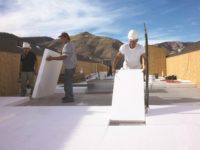Up to 25 percent of a building’s heat loss is through the roof. To help reduce this energy waste, the International Energy Conservation Code (IECC) requires roof insulation in commercial buildings. Effective insulation helps the building owner save on energy costs year after year, while also helping create a comfortable indoor environment.
Fortunately, building professionals have available to them a range of insulation products that keep heat in during the winter and heat out during the summer. These include three common rigid foam insulation types: polyisocyanurate (polyiso), extruded polystyrene (XPS) and expanded polystyrene (EPS). Among these insulations are options that help the building team save money on both materials and labor.
Measuring What Matters
When specifying one of the rigid foam insulations, to get the most value for your money, it is crucial to evaluate how much thermal performance (R-value) you receive per dollar spent. Yet, many insulation manufacturers market their products based on R-value per-inch.
While R-value per inch might be important if your goal is to build the thinnest roof assembly possible, it says nothing about the insulation’s benefits vs. costs. Selecting insulation based on R-value per-inch would be like choosing a gas station based on the number of gallons their pumps dispense per minute instead of choosing based on the price they charge per gallon. In other words, R-value per-inch and gallons dispensed per minute might be somewhat interesting pieces of data, but are largely irrelevant to what most users care about.
As EPS insulation offers the highest R-value per dollar, many building professionals choose it for their roof insulation needs. For those who specify EPS for its cost effectiveness, moisture performance and stable long-term R-values, product options are available that reduce costs even further.
Tapered Systems
Converting a flat or low-sloped roof to a greater slope for better drainage typically requires workers to stack multiple layers of insulation. This can be a labor-intensive process with XPS and polyiso, as crews must haul and place numerous rigid foam sheets of only a few inches of thickness. By comparison, EPS insulation is available in blocks up to 40 inches thick. Manufacturers will cut those blocks to virtually any slope and any shape to fit roof crickets, saddles, valleys and ridges. Tapered EPS speeds up insulation installation and can reduce roof insulation costs up to 30 percent compared to other tapered insulations. Additional cost savings result from reduced dumpster fees to dispose of insulation cut-offs.

Roof Re-Covers
An easy-to-use insulation option for roof recovers in which a separator board is required is EPS panels pre-folded into bundles, with polymeric facers on both sides. Products like R-TECH FF (fan fold) are available in standard sizes up to 200 square-feet (2 squares), comprised of 25 panels that are 2 feet by 4 feet each, and come in various thicknesses. A typical two-square bundle weighs less than 11 pounds, so it is easy for one person to carry.
EPS fanfold bundles require fewer fasteners per square foot than most roofing insulations, and are less expensive than virtually every other recover board. The man-hours needed to install fanfold bundles are about 60 percent less than working with individual sheets. Material costs are also lower than wood fiber, perlite or gypsum board. On large projects, the total savings can add up to tens of thousands of dollars.

Metal Roof Recovers
For metal roof recovers, the standing seams of the metal roofing add a level of complexity for crews to work around to establish a smooth surface for the new roof membrane system. Typically, crews must cut and place numerous pieces of insulation to fill the channels between the standing seams.
An easier alternative is EPS flute fill insulation, which is factory-cut to fit any metal roof flange profile (square, tapered, or profile-cut). By filling in the channels, contractors do not need to worry about their insulation’s ability to span the raised seams without failing. Flute fill insulation also minimizes the use of insulation above the flutes, thereby reducing the possible need to raise curbs and other rooftop systems.
Conclusion
While roof insulation is required by code, and as a practical necessity, it doesn’t have to break the bank. Readily available EPS insulation options can help you save money on commercial roof jobs, in both new construction and building retrofits.




